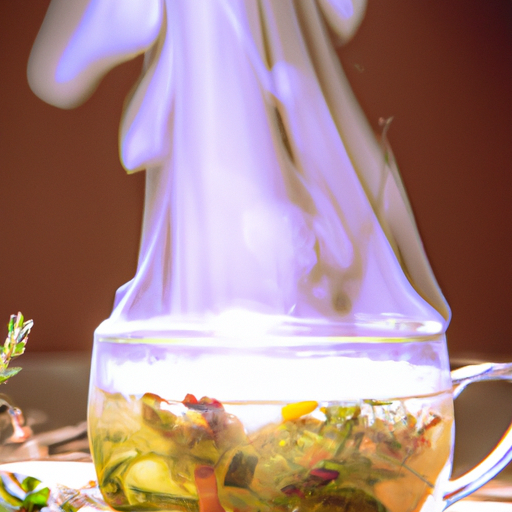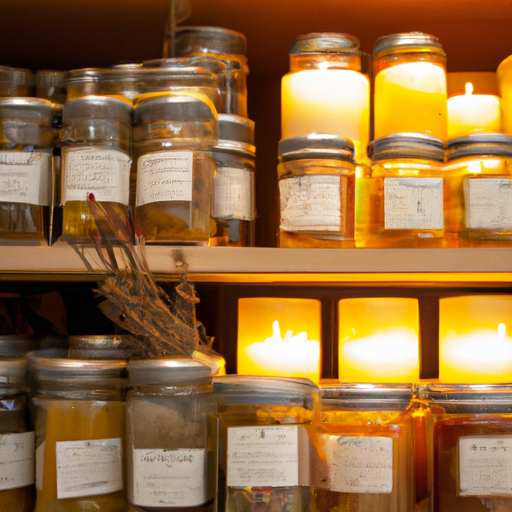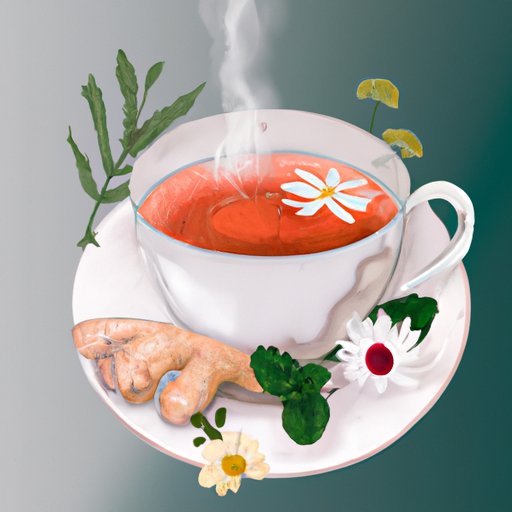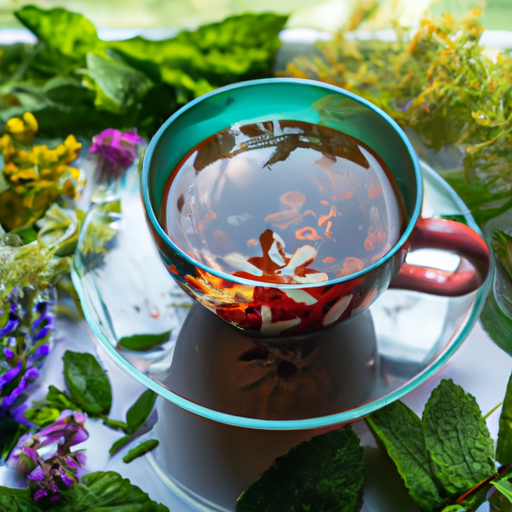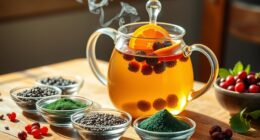Have you ever desired to enjoy the revitalizing taste and countless health advantages of herbal tea? Well, I have a special tip for you. There is a specific herb that can elevate your tea-drinking journey into something truly remarkable. That herb is fresh thyme! Yes, you read that correctly. The fragrant and healing qualities of thyme make it a perfect element for crafting a delightful cup of herbal tea.
But how do you go about making this extraordinary elixir? Fear not, for I am here to guide you through the process step by step. In this article, I will walk you through the gathering of fresh thyme leaves, the preparation of your teapot or infuser, the art of steeping the thyme leaves, the addition of flavorful enhancements, and finally, the straining and serving of your herbal tea.
By the end of this article, you will be able to indulge in the tantalizing flavor of fresh thyme tea while reaping its numerous health benefits. So, let’s get started on this journey of herbal tea mastery!
Key Takeaways
- Thyme is an herb with antimicrobial and antioxidant properties, making it a great ingredient for herbal tea.
- Thyme tea can boost the immune system, improve digestion, and relieve respiratory issues.
- Fresh thyme leaves should be gathered in the morning when the essential oils are concentrated, and they can be air-dried for future use.
- Experiment with different flavors by adding ingredients like dried lavender or chamomile flowers, honey or stevia, and lemon or orange slices to enhance the flavor of thyme tea.
Understanding the Health Benefits of Thyme
So, you’re probably wondering, what’s the deal with thyme? Well, let me tell you, this little herb packs a punch when it comes to health benefits! Thyme has been used for centuries as a natural remedy for various ailments, thanks to its powerful antimicrobial and antioxidant properties.
It is rich in vitamins A and C, as well as minerals like iron and manganese. Incorporating thyme into your daily routine can help boost your immune system, relieve respiratory issues, and improve digestion. Additionally, thyme has been found to have anti-inflammatory effects, making it a great option for those with arthritis or other inflammatory conditions.
So, now that you know about the amazing health benefits of thyme, let’s move on to gathering the fresh thyme leaves.
Gathering the Fresh Thyme Leaves
First, pluck the fragrant leaves of thyme from the stems to infuse your hot water with a burst of savory flavor. Harvesting thyme is a simple task that can be done by gently gripping the stem with one hand and using the other hand to strip the leaves in the opposite direction of growth.
It’s important to gather the leaves when they’re at their peak, usually in the morning when the essential oils are most concentrated. Once you’ve collected a sufficient amount of fresh thyme leaves, you can choose to dry them for future use. Drying thyme involves spreading the leaves out in a single layer on a clean, dry surface and allowing them to air dry for several days until they become crisp.
Once your thyme leaves are ready, move on to preparing your teapot or infuser.
Preparing Your Teapot or Infuser
Before you can savor the aromatic essence of thyme, it’s crucial to ready your teapot or infuser for the brewing process. Here are three important steps to prepare your teapot or infuser:
-
Cleanliness is key: Ensure that your teapot or infuser is thoroughly cleaned and free from any residue or lingering flavors. This will prevent any unwanted flavors from interfering with the delicate taste of thyme.
-
Warm it up: Before adding the thyme leaves, warm up your teapot or infuser by rinsing it with hot water. This’ll help maintain the optimal temperature for steeping and ensure a more flavorful tea.
-
Choose the right size: Pick a teapot or infuser that’s appropriately sized for the amount of tea you plan to brew. Too much empty space can cause the tea to become weak, while overcrowding the leaves may result in an overpowering taste.
Now that your teapot or infuser is prepared, it’s time to move on to steeping the thyme leaves for the perfect cup of herbal tea.
Steeping the Thyme Leaves
To steep the thyme leaves, you’ll want to add them to the warmed teapot or infuser and let them infuse in hot water for the recommended amount of time. Thyme tea offers numerous health benefits due to its natural compounds, including antioxidants and antimicrobial properties. Regular consumption can aid in digestion, boost the immune system, and relieve respiratory issues.
Thyme tea recipes vary, but a simple method involves adding a handful of fresh thyme leaves to boiling water and letting it steep for about 5 minutes. This allows the water to extract the beneficial compounds from the herb. After steeping, strain the tea and it’s ready to drink.
Now, let’s move on to the next section and explore how to add flavorful enhancements to your thyme tea.
Adding Flavorful Enhancements
Enhance your thyme-infused brew with a burst of flavor by adding unique and delightful enhancements. When exploring different tea blends, consider adding a small amount of dried lavender or chamomile flowers to your thyme tea for a soothing and aromatic twist. These floral notes complement the earthy taste of thyme, creating a truly delightful experience for your taste buds. Additionally, experimenting with natural sweeteners such as honey or stevia can elevate the overall flavor profile of your herbal tea. Both honey and stevia provide a touch of sweetness without overpowering the herbal notes of thyme. For a more citrusy flavor, try adding a few slices of fresh lemon or orange to your tea. These citrus fruits add a refreshing tang that pairs well with thyme’s herbaceous taste. Now, let’s move on to straining and serving your herbal tea, ensuring a perfectly brewed cup every time.
Straining and Serving Your Herbal Tea
Now, let’s get ready to strain and serve your aromatic thyme-infused brew, ensuring a perfectly brewed cup of goodness for your enjoyment.
After steeping the tea for the recommended time, you have a few options for straining. The traditional method is to use a fine-mesh strainer or cheesecloth to remove any solid particles, ensuring a smooth and pure tea. However, if you prefer a more rustic experience, you can try alternative straining methods such as using a French press or a tea infuser ball. These methods may allow some particles to remain, but they can add a unique texture and depth to your tea.
Once you have strained your tea, there are various serving options to consider. You can enjoy it hot or pour it over ice for a refreshing iced tea. Adding a squeeze of lemon or a drizzle of honey can enhance the flavor even further.
Moving on to the next section, let’s explore how to fully enjoy the invigorating flavor of fresh thyme tea.
Enjoying the Invigorating Flavor of Fresh Thyme Tea
Indulge in the invigorating essence of a steeped cup of thyme-infused brew, savoring every sip as it revitalizes your senses. Thyme tea is not only a delicious beverage, but it also offers a plethora of health benefits. Here are three ways to explore thyme tea variations and incorporate it into your daily routine:
-
Experiment with flavors: Enhance the taste of thyme tea by adding a hint of lemon or honey for a refreshing twist. You can also mix it with other herbs like mint or chamomile to create unique flavor combinations.
-
Enjoy it hot or cold: Thyme tea can be enjoyed both hot and cold, making it a versatile drink for any season. Sip on a warm cup during chilly mornings or cool down with an iced version on hot summer days.
-
Make it a part of your routine: Incorporate thyme tea into your daily routine by replacing your regular cup of coffee or tea with this herbal infusion. Its natural properties can boost your immune system, aid digestion, and promote overall well-being.
Start exploring thyme tea variations today and experience the delightful flavors while reaping the numerous health benefits it has to offer.
Frequently Asked Questions
Can I use dried thyme leaves instead of fresh thyme leaves to make herbal tea?
I investigated the theory that dried thyme leaves can be used instead of fresh ones to make herbal tea. While there may be a slight difference in taste, dried thyme still offers alternative uses and similar health benefits.
How long should I steep the thyme leaves in hot water?
For optimal flavor and benefits, steep thyme leaves in hot water for 5-10 minutes. Thyme tea aids digestion by promoting healthy gut bacteria and reducing inflammation. Its antimicrobial properties may also help combat certain infections.
Can I sweeten the herbal tea with honey or sugar?
Yes, you can sweeten herbal tea with alternative sweeteners like honey or sugar. Both options add a pleasant taste to the tea. However, be mindful of the amount you use to maintain the health benefits of the herbal tea.
Can I add other herbs or spices to the thyme tea for added flavor?
Absolutely! Adding other herbs and spices to thyme tea can create unique flavor profiles. Combining herbs like chamomile, mint, or lavender can enhance the taste. Additionally, spices like ginger or cinnamon add not only flavor but also numerous health benefits.
Is it safe to consume thyme tea if I have certain medical conditions or take certain medications?
Thyme tea is generally safe to consume, but precautions should be taken if you have certain medical conditions or take specific medications. Its effectiveness for specific medical conditions may vary, so consult your healthcare provider for personalized advice.
Conclusion
In conclusion, making herbal tea with fresh thyme is a simple and delightful way to reap the numerous health benefits of this incredible herb. By steeping the thyme leaves in hot water, you release its powerful antioxidants and antibacterial properties, promoting overall wellness.
The invigorating flavor of the tea is a refreshing treat for the senses, like a burst of sunshine on a cloudy day. So why not indulge in this aromatic elixir and let the soothing power of thyme envelop you like a warm embrace? Cheers to good health!


